
3 Days in Tokyo: Tours, Temples, Food, and Fun...Explor
When you live for years in a city like Tokyo, you learn to always be curious and never take anything for granted. A bustling metropolis that seamlessly blends modernity and tradition, Tokyo is visited by over 14 million people every year…from every country, from every culture, and every walk of life.
But to have the privilege to actually live in the Capital of the East? It has never felt like a tourist attraction to me. I am one of the lucky…I have been given the opportunity to experience this city from a different perspective. For me, it has felt like home.
Table Of Contents
- Living in Tokyo...A time of culture, cuisine, and curiosity
- How to plan the perfect 3 days in Tokyo
- Day 1: The perfect day for discovering the city's highlights
- Day Two: Time for some traditional Tokyo, some hidden gems, and some art
- Day 3: Nature, history, and local cuisine
- 3 days in Tokyo...when will you return?
Living in Tokyo...A time of culture, cuisine, and curiosity
Living in Tokyo, I love being surrounded by its vibrant energy, its delicious cuisine, its fashion-forward style, and its friendly and welcoming people. From the towering skyscrapers to the tranquil shrines, I’ve known from the day I moved here that there was something special about this city.
A true melting pot of different nationalities and backgrounds, it has never been difficult for me to meet a new person and learn about their culture while living in Japan's capital. I don't know if it's the diversity of Tokyo that made me like people so much, or if it’s the fact that I like people so much – but both have made me love Tokyo even more. Either way, I am excited to share it with you.
3 days in Tokyo...Where do we start?

Sit and plan your private tour with your guide
Three days in Tokyo means that we are in for a perfect Tokyo itinerary and a whirlwind ride. This is a city so full of culture and character and excitement and entertainment that there may be little time for sleep! But no one ever visited Tokyo to rest, right?
Luckily, most people who visit Tokyo quickly find that the frenetic energy of this fantastic city fills them with the extra energy they need to take it all in, regardless of how long they're here for or how far they traveled to arrive. And not only that, but when you have the right host and a great 3-day Tokyo Itinerary, you'll find yourself ready to embark on the entire experience.
So grab an extra coffee (or a strong green tea!) and let's get started!
How to plan the perfect 3 days in Tokyo

Choose your favorite attractions
But it can all become overwhelming as well, if a host isn't thoughtful in how they choose to meld it all together for their guests. Here are some quick Tokyo trip planner tips that I like to consider when planning an itinerary for my guests, particularly a three day Tokyo visit:
1. Prioritize the must-see attractions: With only three days in Tokyo, it's important to prioritize the attractions and activities that are most important. You may not be able to see everything, but the highlights will leave you breathless and wanting to come back for more!
2. Group nearby attractions together: When planning the 3 days in Tokyo for any guest, I try to group nearby attractions together to save time on transportation. This will also allow you to see more in a shorter amount of time.
3. Consider the time of year: Tokyo can be crowded at any time of year, but some times are busier than others. It's important to consider the time of year you're visiting and plan accordingly, keeping in mind that cherry blossom season in late March to early April and fall foliage season in November are especially busy. -- and totally worth it!
4. Use public transportation: Tokyo has an extensive and efficient public transportation system, so using the Tokyo Metro Subway lines to get around the city is a great way to save time and money as well as get a better feel for the local culture and city as a whole.
5. Stay flexible: While it's important to have a plan, it's also important to stay flexible and be willing to adjust an itinerary if needed. Unexpected events or delays can happen, so being prepared to adapt is always a good idea. Even though Tokyo is known for being one of the most efficient cities on the planet, there's still a lot that goes on here and a lot that can cause a delay or two.
Now that you've got the basic idea of what a 3-day trip through Tokyo is going to entail, let's get started!
Day 1: The perfect day for discovering the city's highlights
If you only have three days in this beautiful and busy city, I think it's best to start with the city's most iconic attractions. Remember, Tokyo has so much to offer that you could easily spend an entire day at each of these hot spots alone.
But since time is a bit limited, we are going to try and work in a relatively tight timeline and make sure you can experience as much as possible to get the true flavor of this capital city.
Stop 1: A traditional Japanese breakfast at Hatsufuji in Tokyo Station
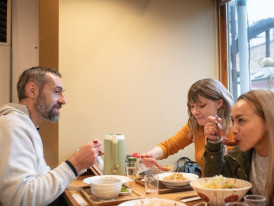
A traditional Japanese breakfast at Hatsufuji
Let's start your first day with a local favorite...a traditional Japanese breakfast at Hatsufuji in Tokyo Station.Located in the underground shopping center below Tokyo Station, Hatsufuji is the perfect place for grabbing a quick (and delicious!) breakfast before heading out to explore the city.
Known for its traditional Japanese breakfast sets, Hatsufuji is a well-loved locale for its simple yet filling meals. We will place our order from a vending machine and have options such as salt-grilled fish, pork and tofu miso soup, and beef simmered with tofu.
All dishes come with a bowl of rice, miso soup, and pickles.
The food is fresh and flavorful, and the cozy atmosphere will give you a real feel for what a traditional "mom-and-pop" type Japanese breakfast looks like. This is a great way to start the day!
Stop 2: Sensoji Temple & Asakusa
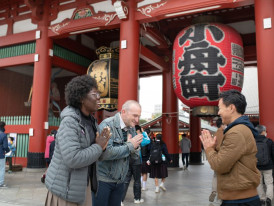
Explore Tokyo's traditional district
After our bellies are satisfied, we will start your Tokyo experience with a place that no one should miss on their first visit to this city...the Sensoji Temple.
Tokyo is a city that's known for its modern and futuristic vibes, but it's also a city with a rich cultural heritage that deserves to be explored as well. And as far as I'm concerned, there is nothing that says "traditional Tokyo" more than Asakusa.Asakusa is a district located in the northeastern part of Tokyo and is known for its historic and traditional atmosphere...one of my favorites to share with guests.
The first stop on our itinerary will be the Sensoji Temple, which is the oldest temple in Tokyo. The temple is famous for its towering entrance gate and the bustling street that leads up to it. Before going in, you can spend a few minutes on the bustling Nakamise shopping street and browse the many shops selling traditional Japanese souvenirs and snacks. We will then enter the temple grounds through the massive Thunder Gate and begin our exploration of the temple grounds.
Despite being destroyed during World War II, the temple was faithfully reconstructed and today remains a stunning example of Japanese Buddhist architecture. It's hard to not be awe-struck by the intricate details of the main hall while you take part in the traditional practice of burning incense and offering prayers.
Next, a short walk from the Sensoji Temple will get us to the Asakusa Shrine, another not to be missed site in this serene area. This shrine is dedicated to the god of the sea and the god of the wind, and it's a peaceful spot to enjoy.
Stop 3: Ueno Park
Our next stop will be one of my all-time favorites, the beautiful Ueno Park.
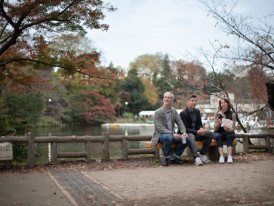
Going in spring is best for cherry blossom
As one of the largest parks in the city, Ueno offers an impressive array of attractions, including the Tokyo National Museum, the Tokyo Metropolitan Art Museum, the Ueno Zoo, and several shrines and temples. Strolling through the park on its winding paths, it is easy to become captivated by the natural beauty of the landscape, with its lush greenery and tranquil ponds...all while still being in the middle of a pulsing city! The park's numerous cherry blossom trees are particularly stunning, especially when they are in bloom in late spring. The delicate pink petals create a vibrant and photo-worthy for any traveler.
Stop 4: Explore the Tokyo National Museum
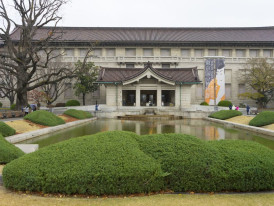
One of the largest and oldest museums in Japan
By now, you (and your feet!) may be ready to get off the busy streets for a bit, so we will head on over to the Tokyo National Museum, a true treasure trove of Japanese art and history that any visitor to Tokyo will appreciate getting to glimpse. Located in the northern section of Ueno Park, this national museum is one of the largest and oldest museums in Japan, with a collection that spans thousands of years.
Though it's massive, the designers of this national treasure did an excellent job of dividing it into several galleries, each showcasing different aspects of Japanese history and culture. The displays include pottery, ceramics, textiles, armor, weapons, sculptures, and paintings, as well as artifacts from ancient Japan and other Asian countries.
One of my favorite highlights of the museum is the gallery of Japanese swords and armor. The displays are incredibly intricate and well-preserved, and you can see the craftsmanship and detail that went into creating these weapons. I also love the beautiful garden that's outside the walls and features a traditional Japanese tea house, a pond, and several walking paths that are perfect for a leisurely stroll and to spend a few minutes regrouping before our next adventure starts.
Stop #5: Lunch at Innsyoutei
After we visit our first museum, another traditional Japanese meal will await us at Innsyoutei, a restaurant famous for its tempura and teishoku sets. And though I love the museums and beauty of Ueno Park, I think that experiencing a meal at this special spot makes this day one that you can't forget. Shoes off are a must here and it's apparent that soft voices and respect are highly valued from the moment you walk in. Innsyoutei has a simple tearoom on the ground floor, and private tatami rooms, and a dining room on the second floor.
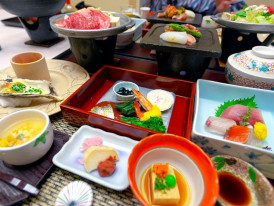
Japanese meal will await us at Innsyoutei
Though a restaurant steeped in tradition, there is still an English-language menu and an amazingly friendly wait staff. For such a popular place, the prices are very reasonable for set lunches that include options like a vegetarian choice, bento, and kaiseki. During the cherry blossom season, when Ueno Park completely erupts in a flame of pink flowers and hordes of people, Innsyoutei usually limits its menu to only a few set meals, but each bite will be as breathtaking as the blooms at this special spot.
Stop 6: Ueno's Ameyoko
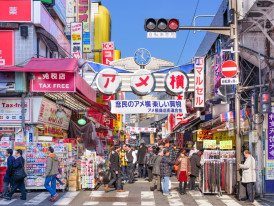
Shop till you drop at Amayoko
After lunch, we will head back out onto the street and spend some time discovering Ameyoko, a vibrant and lively marketplace that offers a fun and unique shopping experience.
With its narrow streets and crowded alleys, Ameyoko is a hub for bargain hunters and foodies alike. The market is home to a wide range of shops, selling everything from fresh seafood and exotic spices to trendy fashion items and just about any electronic or gadget that you can think of.
Stop 7: Tokyo Metropolitan Art Museum
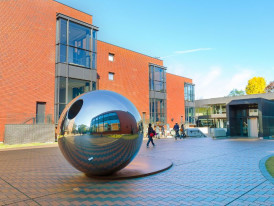
Tokyo Metropolitan Art Museum with its special exhibit
One more museum is a must before we leave Ueno Park. The Tokyo Metropolitan Art Museum features a vast collection of Japanese artists but it also has a great deal of international art as well.
One of the highlights of the Tokyo Metropolitan Art Museum is its special exhibitions, which change frequently throughout the year. These exhibitions showcase works from both established and emerging artists and cover a range of styles and themes. The museum itself is also modern and spacious, with natural light filtering in from skylights and large windows.
Stop 8: Shibuya Crossing
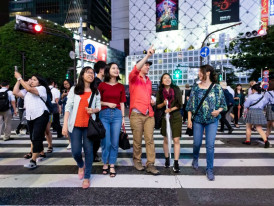
The busiest crossing the world
Our next adventure will be to take the metro to Shibuya Station. Once we emerge, we will be in the heart of the bustling and famous Shibuya Crossing, one of the busiest pedestrian crossings in the world.
In all my years of living in Tokyo, I never tire of watching - awestruck - the happenings that go on at Shibuya Crossing. It always gives my guests a feel of the true pulse of this magnificent city. Shibuya Crossing is one of the most recognizable sites in all of Japan and has been captured in countless movies, advertisements, and other forms of pop culture. During the busiest times of the day, more than 2000 people are found to be crossing through the intersection every two to three minutes...that's the same number it would take to fill an American football stadium!
Depending on your energy at this point, you have a few different options for how you want to experience this phenomenon. We can stand and watch for a few minutes or join in the organized chaos and experience the crossing ourselves! It's a thrilling experience and one that will leave you feeling like you're part of something bigger than just yourself.
Another option is to watch the excitement transpire from the Starbucks on the second floor of the Tsutaya building. From here, we will have a bird's eye view of the crossings and can sit back and sip our lattes as we watch the crowds rush by. The Starbucks, as you can imagine, is usually packed, but I think it's well worth waiting for a seat as it provides a unique perspective on the crossing and will give us a few minutes to begin to talk about the rest of our day.
And, for those of you who don’t care for Starbucks or aren't in the mood for coffee, there is the Shibuya Hikarie which is a great shopping and entertainment complex that has a free observation deck on the 11th floor…great for viewing the Shibuya Crossing as the night falls and the evening hustle begins.
Stop 9: Dinner at Gyukatsu Motomura
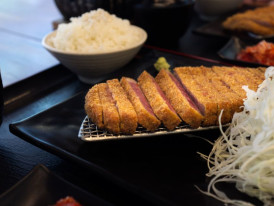
Gyukatsu is a breaded beef cutlet that is quickly deep-
Our dinner stop will be at Gyukatsu Motomura, the small and cozy establishment that is known for its specialty, gyukatsu, a dish consisting of breaded and deep-fried beef cutlets.
It is quite common in Japan for a restaurant to specialize in one specific dish, and you will get the real feel for that here.
The menu is simple and straightforward, with the main focus being on the quality of the meat. The staff is friendly and welcoming, and the atmosphere is casual and relaxed. That said, there is almost always a line of patrons anxious to find a seat inside, so we may have to wait. But... when you stand and smell all the wonderful aromas wafting out the front doors, you know your wait will be worth it.
Gyukatsu is a breaded beef cutlet that is quickly deep-fried, leaving it rare on the inside and rich on the outside. At Gyukatsu Motomura, the beef is cooked to perfection and the taste shines through the thin breading. It's usually served with a side of rice, miso soup, and pickled vegetables as well.
Stop 10: Night in Shinjuku
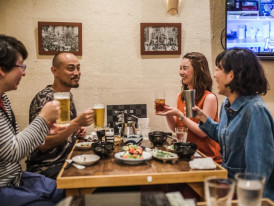
Shinjuku is one of the most vibrant areas in Tokyo for
If you are still ready to roll, a night out in Shinjuku will be a great way to end this first day.
Shinjuku is one of the most vibrant areas in Tokyo for a night out. From bars and clubs to karaoke, Shinjuku has it all. The neon lights and crowded streets make for an electrifying atmosphere, and there are endless options to suit any taste or budget. Two spots that are worth checking out are Omoide Yokocho and Golden Gai.
Omoide Yokocho (also known as Memory Lane) is a narrow alleyway located in the heart of Shinjuku. It is a throwback to the post-World War II era of Japan, with narrow alleys and small stalls selling a variety of traditional Japanese foods and drinks. The atmosphere is lively and bustling, with sights, sounds, and smells filling the air around you.
Just a short walk from Omoide Yokocho is Golden Gai, a network of six narrow alleys filled with hundreds of tiny bars and restaurants. Golden Gai is known for its unique and intimate atmosphere, with each bar only seating a handful of customers at a time. Shinjuku is also home to Kabukicho, which is Tokyo's largest red light district and offers a unique experience with its bright lights and lively atmosphere.
Whether you're looking for a night of bar hopping, a lively club scene, or just want to pass a few hours of people-watching, Shinjuku has something for everyone. Though it will be crowded and a bit overwhelming, it's a site you certainly can't miss.
Day Two: Time for some traditional Tokyo, some hidden gems, and some art
After an action-packed first day in Tokyo, we will start this morning with a breakfast that will surely help us prepare for another memorable Tokyo day!

A Happy Pancake is a popular restaurant chain in Japan
Stop 1: Souffle pancakes at A Happy Pancake
A Happy Pancake is a popular restaurant chain in Japan that offers the fluffiest pancakes you've ever tasted. These are a must-try for getting our second day off to the right start. Their signature dish is the Happy Pancake, the softest pancakes made with Hokkaido butter and New Zealand honey...delightful!
Stop 2: Meiji Shrine
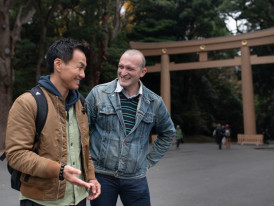
The Meiji Shrine, located in Shibuya, Tokyo
Not far from A Happy Pancake is the Meiji Shrine and our first official touring site of the day.
The Meiji Shrine, located in Shibuya, Tokyo, is a Shinto shrine dedicated to the deified spirits of Emperor Meiji and his consort, Empress Shoken. Emperor Meiji was a transformative figure for the Japanese, overseeing Japan's modernization and transformation into a world power in the late 19th century.
The Meiji Shrine was built in the emperor's honor after he died in 1912. The shrine was destroyed during World War II but was rebuilt in 1958 through donations from the Japanese people. Today, the Meiji Shrine is a peaceful retreat in the heart of bustling Tokyo. The shrine itself is awe-inspiring, with its grand wooden structures, intricate details and incense-filled air which adds to its sense of tranquility and spirituality.
Stop 3: Yoyogi Park
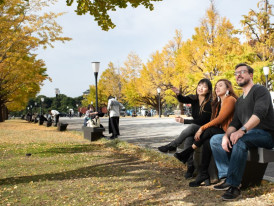
Famous for its beautiful foliage
When visiting Tokyo, your trip can not be complete without getting to spend some time in Yoyogi Park, a sprawling and spectacular public park located in the heart of Tokyo.
Famous for its beautiful foliage, sprawling lawns, and vibrant atmosphere, this park is top on the tourist attractions list but is well-loved by locals as well, for its rich history that plays a big role in Japanese culture still today. The history of Yoyogi Park dates back to the early 20th century when it served as a military parade ground for the Imperial Japanese Army.
One of the park's most iconic features is its large open space, which is perfect for picnics, sports, and other outdoor activities. The park is also home to several small shrines and temples, including the Meiji Shrine, a popular destination for those seeking a quiet respite from the hustle and bustle of my massive city.
Throughout the year, the park hosts a variety of events and festivals, including the annual Super Yosakoi Festival, a colorful and energetic celebration of dance and music that is a huge favorite for locals and travelers alike. But even if your Tokyo trip doesn't fall during one of these times, this park is a must-see and a nice way to spend an hour or two during your 3 days in Tokyo. This is highly recommended on your Tokyo walking tour.
Stop 4: Harajuku and Takeshita Street (kawaii culture).
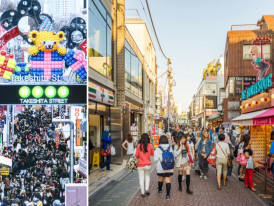
The street is lined with small shops and quaint boutiqu
Harajuku is a vibrant and trendy district in Tokyo, Japan that is well-known for its unique fashion and kawaii culture (kawaii meaning "cute" in Japanese.)
Takeshita Street, a narrow pedestrian street in Harajuku, is the heart of this culture and attracts tons of attention from tourists and locals alike. The street is lined with small shops and quaint boutiques that sell a variety of colorful and quirky clothing, accessories, and just about every novelty item you can think of.
Here, you will be able to buy anything from crepes (almost too cute to eat!) and rainbow-colored cotton candy to lacey lingerie and exotic fashion-forward clothes that can create any look you're trying to emulate. The area is often crowded with young people dressed in eclectic and creative outfits, making this the perfect destination for those interested in exploring the city's youthful and (and more playful!) side.
Stop 5: Lunch at Sushi Hiro
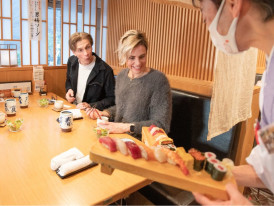
Sushiro is a popular sushi chain in Japan
A popular sushi restaurant in Omotesando is Sushi Hiro, which serves high-quality sushi and sashimi at reasonable prices. Sushiro is a popular sushi chain in Japan with locations throughout the country, including this branch in the trendy Omotesando area of Tokyo.
One of the standout features of Sushiro is the affordable prices for the quality of the sushi. The restaurant offers a variety of sushi options, including nigiri, maki, and sashimi, as well as a selection of side dishes and drinks.
The interior of Sushiro in Omotesando is sleek and modern, with a minimalist design that lets the focus remain on the food. The sushi chefs work at a counter in the center of the restaurant, allowing diners to watch as their sushi is prepared. The restaurant can get busy, so we may have to wait a few minutes to be seated...but believe me, we'll be glad we did!
Stop 6: Upscale shopping district of Omotesando
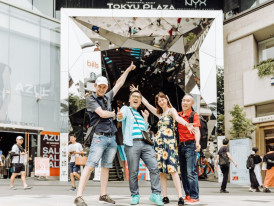
A unique shopping experience
Known as the Champs-Élysées of Tokyo, Omotesando’s tree-lined streets are filled with beautiful shops, funky cafes, and great restaurants. Omotesando is one of the most upscale shopping districts in Tokyo, offering an array of high-end designer stores and luxurious boutiques.
Walking down the street, you'll find yourself surrounded by some of the most prominent names in the fashion industry from Prada to Gucci to Louis Vuitton. But it's not all about luxury brands in this part of the city...there are also plenty of quirky, independent shops and concept stores that offer a unique shopping experience.
What sets Omotesando apart from other shopping districts in Tokyo is its architectural beauty above all else. The buildings in this area are designed by some of the world's most renowned architects, making for a stunning streetscape. And, right in the middle of all this modern glass and steel behemoths, is the lovely tree-lined avenue, a popular spot for people-watching and window-shopping. With fashionable locals and tourists alike strolling down the street, plenty of time can be passed here.
Stop 7: Kagurazaka district
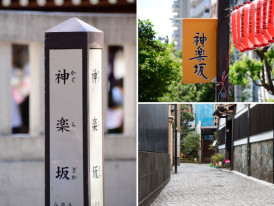
Kagurazaka is a hidden gem in Tokyo
Kagurazaka is a hidden gem in Tokyo that is often overlooked by tourists, but is a must-visit for those who want to experience a more traditional and laid-back side of this city. This charming district is located just a short distance from the bustling Shinjuku and is filled with narrow alleyways, traditional shops, and quaint cafes. The area has a rich history and was once home to geisha and samurai, which is evident in the architecture and ambiance.
One of the main draws of Kagurazaka is its food scene, which is filled with traditional Japanese restaurants and trendy cafes. Visitors can try local delicacies like wagashi (Japanese sweets), soba noodles, and authentic sushi. The area is also home to a number of galleries and museums, making it a great spot for art enthusiasts. This district is particularly enchanting during the autumn months, when the stately trees show off their vibrant fall foliage.
Stop 8: Dinner at Gonpachi in Nishi-Azabu
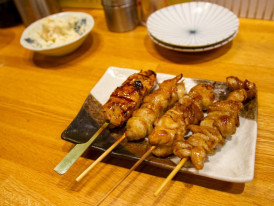
A favorite dish to try at Gonpachi is the yakitori skew
The restaurant that inspired the set for Kill Bill is another favorite of mine to take guests to while in Tokyo. Gonpachi may cater a bit more to the tourist, but it definitely offers a unique dining experience in Tokyo.
The warehouse-style restaurant is inspired by traditional Japanese architecture and features an open courtyard with a large tree in the center, creating a relaxing atmosphere, a rock wall, and glowing lanterns in the evening. Inside is just as cool, with stone floors, rustic wooden beams, and more glowing lanterns. At the heart of the sunken ground floor sits a steaming, bustling open kitchen that puts on quite the show.
The menu at Gonpachi includes a variety of Japanese dishes such as sushi, sashimi, tempura, and yakitori. A favorite dish to try at Gonpachi is the yakitori skewers. The chicken is always grilled to perfection and seasoned with a savory soy sauce that complements the tender meat. The tempura is always tasty as well - light and crispy, with a delicate batter that doesn't overpower the ingredients.
Stop 9: Mori Art Museum
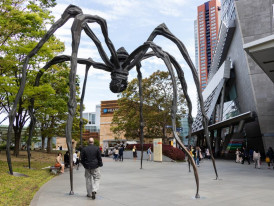
The Mori Art Museum is a must-visit destination
The Mori Art Museum is a must-visit destination for any art lovers visiting Tokyo, and since it doesn't close until 10 pm, it will be our perfect after-dining spot to stop tonight. The museum boasts an impressive collection of contemporary art from around the world, with a focus on Asian artists and their works. I have spent many a morning strolling through the various exhibits in this spectacular space and I never tire of it. As we ascend the tower, we will be greeted by stunning panoramic views of Tokyo just waking up.
This will serve as a perfect prelude to the art that awaits us when we get to our destination on the 53rd floor. The museum's airy and spacious galleries provide a serene and contemplative atmosphere for visitors to appreciate the art on display. One of the highlights (in my opinion) of the Mori Art Museum is its rotating exhibitions that feature works by some of the most exciting and innovative contemporary artists from Asia and beyond.
Recent exhibitions showcase various popular artists from around the region and the museum's permanent collection also includes works by some of the most significant contemporary artists of the 21st century, such as Cai Guo-Qiang and Lee Ufan.
After a tour of the museum, we can make our way to the Mori Tower observation deck for a stunning view of the city at night.
Day 3: Nature, history, and local cuisine
Stop 1: Hamarikyu Gardens
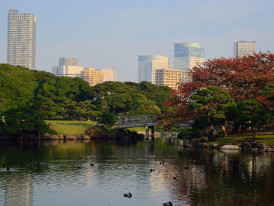
Hamarikyu Gardens is a serene oasis in the bustling cit
Hamarikyu Gardens is a serene oasis in the bustling city of Tokyo. This stunning public garden is a beautiful combination of modern and traditional Japanese design, with picturesque ponds, walkways, and bridges that lead visitors on a journey through time.
As you stroll along the winding paths of the garden, you'll encounter a range of beautiful flora, including seasonal flowers, cherry blossoms, and even a 300-year-old pine tree that has been carefully pruned to almost resemble a weeping willow. The garden also boasts a tranquil teahouse that offers visitors the chance to experience a traditional Japanese tea ceremony, complete with matcha tea and sweet treats as well.
Stop 2: Tsukiji Outer Market for a late sushi breakfast at Tsukiji Kagura Sushi Honten
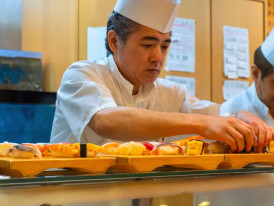
The iconic Tsukiji Outer Market
The iconic Tsukiji Outer Market is a must-visit for our last breakfast together in Tokyo. This bustling marketplace is full of vendors selling the freshest seafood, produce, and traditional Japanese snacks. For a late sushi breakfast, my favorite is Tsukiji Kagura Sushi Honten. The restaurant's sushi chefs use only the highest quality ingredients and the sushi is served in the traditional Edomae style, meaning it's made right in front of you while you wait. The atmosphere here is casual and welcoming, and the prices are reasonable considering the quality of the food.
Stop 3: Yanaka district
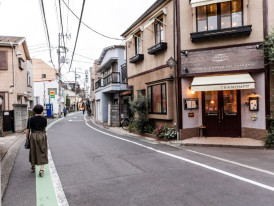
Yanaka still retains a similar bohemian spirit.
Yanaka is a charming, historic district located in the northeastern part of Tokyo. It's known for its traditional architecture, narrow alleys, and abundance of small shops and cafes. This hidden gem was spared the Allied fire bombings during WWII and survived the Great Kanto Earthquake and Fire of 1923. The area has always been a thriving artisan town housing some of Japan's most famous writers and visual artists.
Today, Yanaka still retains a similar bohemian spirit. You'll see that there is still an abundance of and diversity of craft still being produced in the area: textiles, ink prints, wood carvings, traditional cuisines, jewelry, pottery, and, even more.
Stop 4: Lunch at "Nenotsu," a famous udon restaurant in the area.
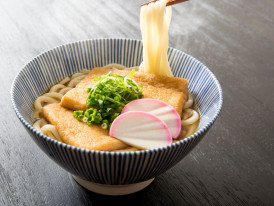
Udon made on site
Nenotsu is a popular udon restaurant located in the bustling city of Tokyo. Situated in the neighborhood of Takadanobaba, this hidden gem is a must-visit for any udon lover. As soon as you enter the restaurant, the warm and welcoming ambiance will make you feel at home. The interior is simple, with a traditional Japanese touch, and the open kitchen allows you to watch the chefs in action.
The star of the show, of course, is the udon. Made fresh on-site, these udon noodles are soft and chewy, and the broth is both rich and flavorful. The menu offers a variety of options, the portions are generous, and the prices are reasonable, making it a great spot for a casual lunch on our third day.
Stop 5: Kakigori at Himitsudo
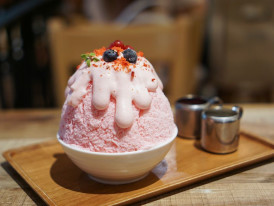
Shaved ice for a hot day of exploring
For a lovely, after-lunch treat, let's stop by Himitsudo, a popular shaved ice spot in the bustling Shinjuku neighborhood. The atmosphere of Himitsudo is cozy and inviting, with a simple and elegant interior design. The staff is also quite friendly, making the experience even more enjoyable. The menu offers a variety of classic and creative flavors, such as strawberry milk, matcha, and caramel, as well as seasonal flavors that change throughout the year.
Stop 6: Tokyo Tower
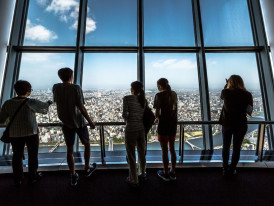
Enjoy a breathtaking view of Tokyo's skyline
I always like to save the Tokyo Tower for the late afternoon and/or evening since the views are simply breathtaking at night. One of the highlights of the Tokyo Tower that I like to share with my guests is the observation deck, which is located at a height of 150 meters (that's almost 500 feet for you Americans!)
From here, you can enjoy a breathtaking view of Tokyo's skyline, including famous landmarks such as Mount Fuji, Tokyo Skytree, and the Rainbow Bridge. The view is especially stunning as the day becomes night and the entire beautiful city of Tokyo begins to light up with its neon signs and lights.
For those of you who still have some energy left before dinner, the other awesome feature of the Tokyo Tower is the "One Piece Tower", an amusement park based on the popular anime and manga series "One Piece". The park features several attractions, including a live show, a 4D cinema, and a variety of games and exhibits that will delight anyone who is a fan of the series (and possibly even make you into a fan after you see it!)
The Tokyo Tower also has several restaurants and cafes and this is where I usually like to take people to eat after a fully packed first day. There is a great revolving restaurant (located at a height of 250 meters) but there are also plenty of other options that will offer us gorgeous views of the city while we dine and talk about our day.
(Note: Though it’s probably not close enough to see during this time period, another spot that may be worth trying to fit in at another time is the Tokyo Metropolitan Government Building.
Though the Tokyo Metropolitan Government Building is not steeped in as much history as a few of the other stops on our 3 day Tokyo tour, it still is a landmark site that deserves to be seen at some point..maybe during your next visit to this fantastic city?
Stop 7: Imperial Palace of the Emperor of Japan
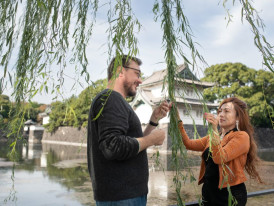
Imperial Palace of the Emperor of Japan
The Tokyo Imperial Palace is the official residence of Japan's imperial family and the palace and its grounds are clearly steeped in Japanese tradition and can provide all of us a glimpse into the country's rich imperial past.
Though the palace itself isn't open for visitors, we will be able to spend some time touring the Imperial Palace East Garden, which were once part of the palace grounds and are now open to the public. The Imperial Palace East gardens are meticulously maintained and feature a variety of traditional Japanese garden elements, including ponds, bridges, and stone lanterns.
For a truly unique Tokyo experience, visitors will be able to see the remains of the Edo Castle, which once stood on the site and was the residence of the Tokugawa shoguns. The Edo Castle has remnants of walls and moats still visible from days past, which will really give you a sense of the scale and grandeur of the former palace.
Stop 8: Ginza
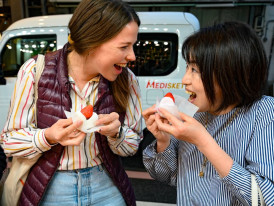
A shopping district for everyone known for its deliciou
As our time together is winding down, no visit to Tokyo is going to be complete without some shopping together at Ginza, the favorite frenetic spot for fashionistas and shopping enthusiasts everywhere. Ginza has something for everyone -- it's a charming shopping street that's a hidden gem offering visitors a glimpse into Tokyo's past with its narrow streets, traditional shops, and cozy cafes.
It's also the perfect place to explore if you're looking for a more laid-back atmosphere away from the hustle and bustle of the city.
The street is lined with various small shops such as traditional sweet shops, toy stores, and a lovely second-hand bookstore. There are also plenty of street food vendors where you can try different local snacks like some of the ones listed below:
1. Menchi Katsu: A popular street food snack in Yanaka Ginza. One of the famous shops serving it is "Niku no Suzuki."
2. Taiyaki: This fish-shaped cake is typically filled with sweet red bean paste, custard, or other fillings.
3. Dango: Sweet rice flour dumplings served on skewers, often coated with a sweet soy sauce glaze.
4. Yakitori: Grilled skewers of chicken or other meats can be found at small eateries along the street.
5. Senbei: Traditional Japanese rice crackers come in various flavors and textures.
6. Traditional Japanese sweets (wagashi): such as dorayaki, mochi, and manju.
Stop 9: Dinner at Tempura Kondo
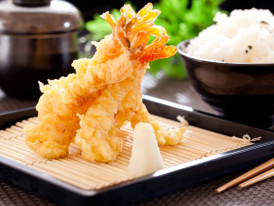
Tempura Kondo is a Michelin-starred culinary masterpiec
Tempura Kondo is a Michelin-starred culinary masterpiece nestled in the heart of Tokyo. From the moment you walk into the restaurant, you are transported to a serene world of truly traditional Japanese elegance. The interior is beautifully designed with a calming atmosphere, making it the perfect place to enjoy a luxurious meal. The menu is focused on the art of tempura, with a variety of fresh and seasonal ingredients delicately battered and fried to perfection.
From the famed sweet potato to the baby onion to the ginger flower, the options here feel endless. Each dish is meticulously crafted while being prepared right in front of your eyes. The tempura batter is so that it may ruin you from ever being able to eat tempura again! Whether it's the succulent shrimp or the tender vegetables, enjoying your last Tokyo meal at Tempura Kondo is sure to be a highlight of your trip.
3 days in Tokyo...when will you return?

Enjoy your perfectly curated 3 day tour
Many of my guests have reached out to me upon their return home to thank me for an unforgettable experience while visiting Tokyo and let me know that they plan to return.
Let's face it...a city of this size and this energy is hard to fully grasp in a short period of time. Even for me, a longtime resident of this amazing city, it sometimes feels as though there are unexplored areas still popping up all around me! That said, spending three days in Tokyo will give you a taste of what this eastern capital has to offer.
From immersing yourself in the traditional culture of Asakusa to soaking up the futuristic atmosphere of Shinjuku, Tokyo truly is a melting pot of tours, temples, food and fun. The delicious delicacies, friendly locals, and unique blend of old and new make a trip to Tokyo one that will stay with you long after you return home.
Just let me know when you plan to return!




